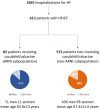ARNI in HFrEF-One-Centre Experience in the Era before the 2021 ESC HF Recommendations
- PMID: 35206278
- PMCID: PMC8872461
- DOI: 10.3390/ijerph19042089
ARNI in HFrEF-One-Centre Experience in the Era before the 2021 ESC HF Recommendations
Abstract
Background: Sacubitril/valsartan, an angiotensin receptor-neprilysin inhibitor (ARNI), has demonstrated a survival benefit and reduces heart failure hospitalization in patients with heart failure with reduced left ventricular ejection fraction (HFrEF); however, our experience in this field is limited. This study aimed to summarize a real clinical practice of the use of ARNI in HFrEF patients hospitalized due to HFrEF in the era before the 2021 ESC HF recommendations, as well as assess their clinical outcome with regard to ARNI administration.
Methods and materials: Overall, 613 patients with HFrEF hospitalized in 2018-2020 were enrolled into a retrospective one-centre cross-sectional analysis. The study population was categorized into patients receiving (82/13.4%) and not-receiving (531/82.6%) ARNI. Clinical outcomes defined as rehospitalization, number of rehospitalizations, time to the first rehospitalization and death from any cause were analysed in the 1-2 year follow-up in the ARNI and non-ARNI groups, matched as to age and LVEF.
Results: Clinical characteristics revealed the following differences between ARNI and non-ARNI groups: A higher percentage of cardiovascular implantable electronic devices (CIED) (p = 0.014) and defibrillators with cardiac resynchronization therapy (CRT-D) (p = 0.038), higher frequency of atrial fibrillation (p = 0.002) and history of stroke (p = 0.024) were in the ARNI group. The percentage of patients with HFrEF NYHA III/IV presented an increasing trend to be higher in the ARNI (64.1%) as compared to the non-ARNI group (51.5%, p = 0.154). Incidence of rehospitalization, number of rehospitalizations and time to the first rehospitalization were comparable between the groups. There were no differences between the numbers of deaths of any cause in the ARNI (28%) and non-ARNI (28%) groups. The independent negative predictor of death in the whole population of ARNI and non-ARNI groups was the coexistence of coronary artery disease (CAD) (beta= -0.924, HR 0.806, p = 0.011).
Conclusions: Our current positive experience in ARNI therapy is limited to extremely severe patients with HFrEF. Regardless of the more advanced HF and HF comorbidities, the patients treated with ARNI presented similar mortality and rehospitalizations as the patients treated by standard therapy.
Keywords: ARNI; HF; HFrEF; heart failure; heart failure with reduced left ventricular ejection fraction; sacubitril/valsartan.
Conflict of interest statement
The authors declare no conflict of interest.
Figures


References
-
- McMurray J.J., Packer M., Desai A.S., Gong J., Lefkowitz M.P., Rizkala A.R., Rouleau J., Shi V.C., Solomon S.D., Swedberg K., et al. Dual angiotensin receptor and neprilysin inhibition as an alternative to angio-tensin-converting enzyme inhibition in patients with chronic systolic heart failure: Rationale for and design of the Prospective comparison of ARNI with ACEI to Determine Impact on Global Mortality and morbidity in Heart Failure trial (PARA-DIGM-HF) Eur. J. Heart Fail. 2013;15:1062–1073. - PMC - PubMed
-
- Ponikowski P., Voors A.A., Anker S.D., Bueno H., Cleland J.G.F., Coats A.J.S., Falk V., González-Juanatey J.R., Harjola V.P., Jankowska E.A., et al. 2016 ESC Guidelines for the diagnosis and treatment of acute and chronic heart failure: The Task Force for the diagnosis and treatment of acute and chronic heart failure of the European Society of Cardiology (ESC). Developed with the special contribution of the Heart Failure Association (HFA) of the ESC. Eur. Heart J. 2016;37:2129–2200. Corrigendum in Eur. Heart J. 2021, 42, 4901. - PubMed
-
- Seferovic P.M., Ponikowski P., Anker S.D., Bauersachs J., Chioncel O., Cleland J.G., De Boer R.A., Drexel H., Ben Gal T., Hill L., et al. Clinical practice update on heart failure 2019: Pharmacotherapy, procedures, devices and patient management. An expert consensus meeting report of the Heart Failure Association of the European Society of Cardiology. Eur. J. Heart Fail. 2019;21:1169–1186. doi: 10.1002/ejhf.1531. - DOI - PubMed
-
- Yancy C.W., Januzzi J.L., Allen L.A., Butler J., Davis L.L., Fonarow G.C., Ibrahim N.E., Jessup M., Lindenfeld J., Maddox T.M., et al. Writing Committee. 2021 Update to the 2017 ACC Expert Consensus Decision Pathway for optimization of heart failure treatment: Answers to 10 pivotal issues about heart failure with reduced ejection fraction. J. Am. Coll. Cardiol. 2021;77:772–810. - PubMed
MeSH terms
Substances
LinkOut - more resources
Full Text Sources
Medical
Research Materials
Miscellaneous

